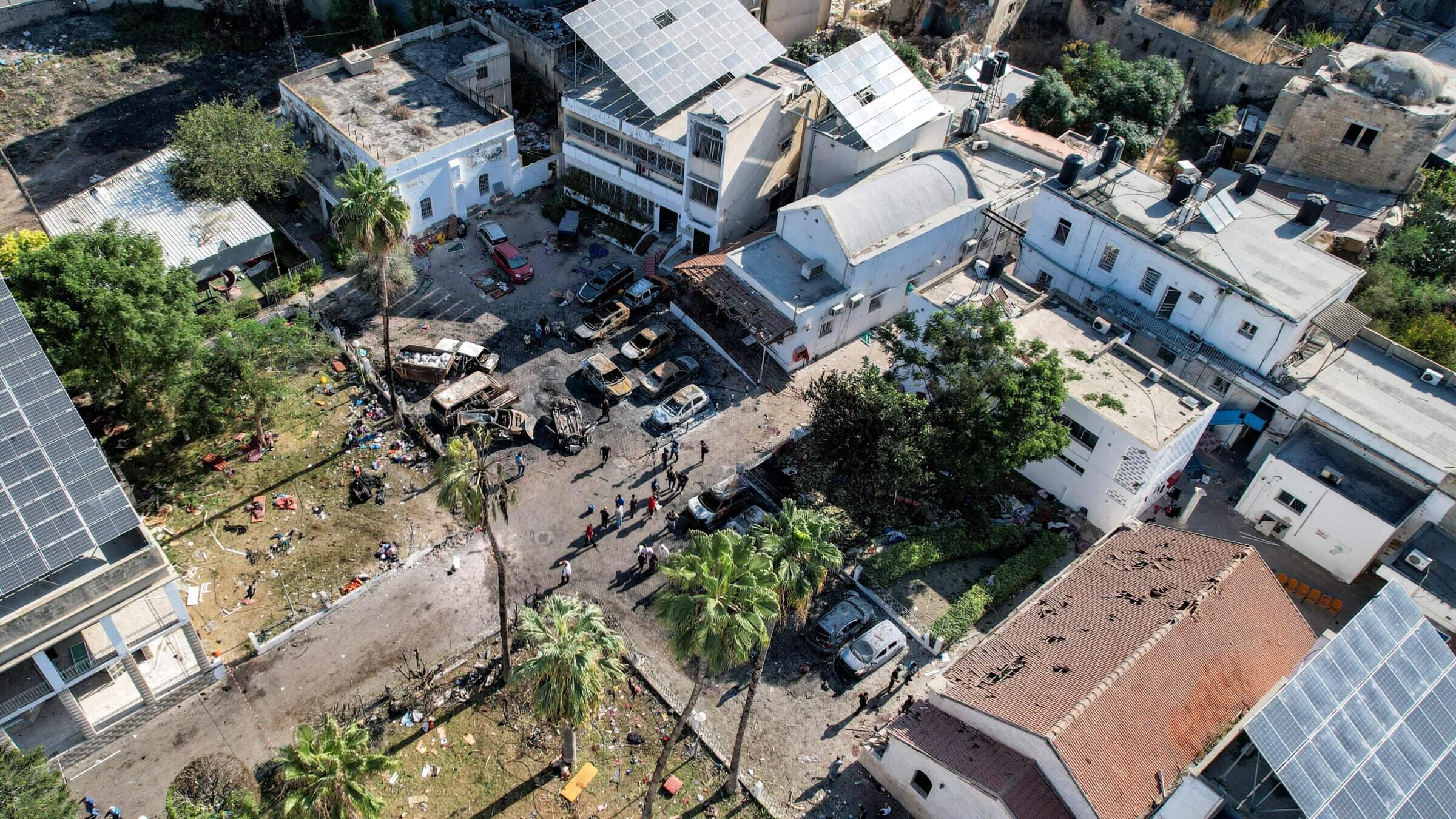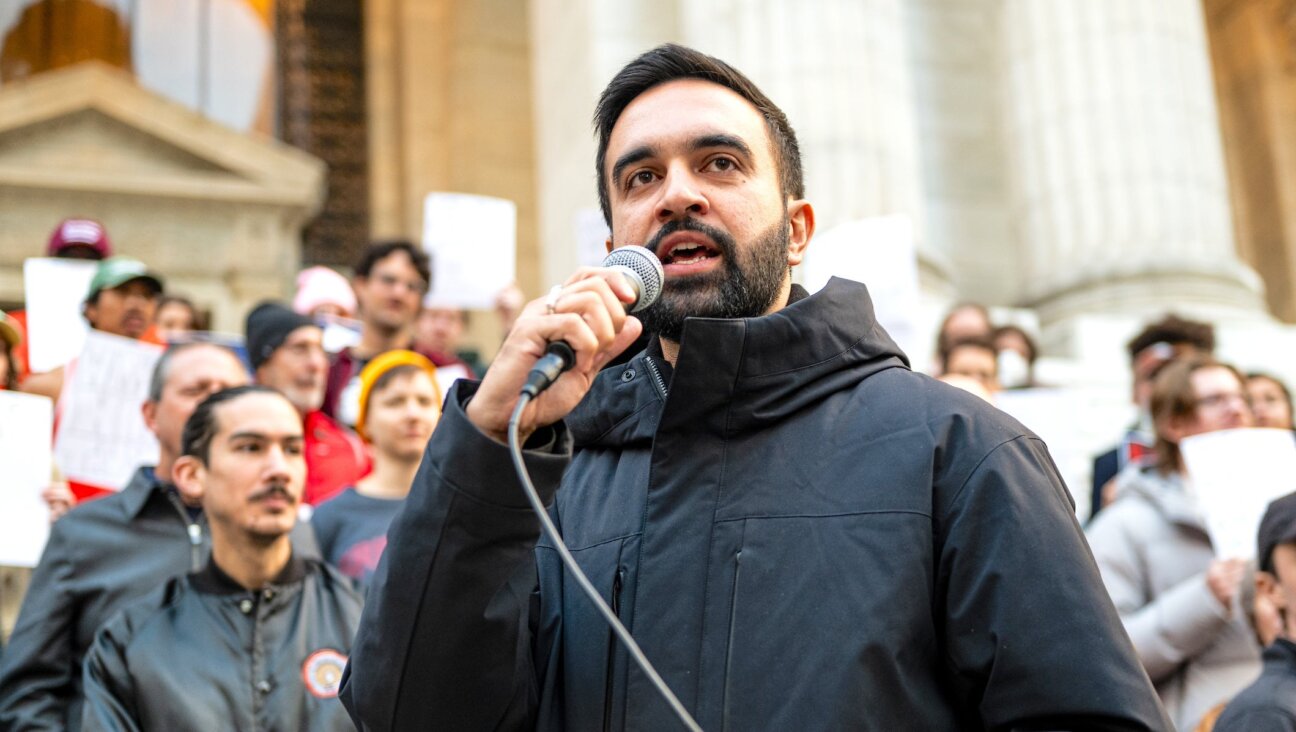The shifting narratives of the Gaza hospital bombing: 24 hours in a fog of war story
As the world scrambled to figure out who bombed a hospital in Gaza, people analyzed videos and spread unverified theories online

This picture taken on October 18, 2023 shows an aerial view of the complex housing Al Ahli Arab hospital in Gaza City in the aftermath of an overnight blast. Photo by Getty Images
When an explosion at Gaza’s Ahli Arab hospital reportedly killed 500 Palestinians on Tuesday afternoon, nearly everyone instantly seemed sure what had happened: News outlets and everyday citizens alike declared that the culprit was an Israeli airstrike.
But shortly after the news broke, Israel denied responsibility, later releasing videos and audio as evidence for their claim that the explosion was caused by a misfired rocket from the Palestinian Islamic Jihad, a Hamas-aligned militant group. By the next morning, President Joe Biden, landing in Tel Aviv, blamed the “other team,” based on U.S. intelligence agencies’ analysis.
On Thursday, the Times, along with other mainstream outlets, revised the estimated death toll, estimating between 100 and 300 dead in the blast based on analysis from American intelligence agencies. Yet for many people, suspicious of official sources and news reports alike, this did little to impact their conclusions.
It may be weeks or months before we know for sure what happened at the hospital. But it already offers an alarming case study of a crucial front in this war between Israel and Hamas. Just as the century-old Israeli-Palestinian conflict is as much about narratives as about land, this war is one of both airstrikes and information.
Israel, Hamas and their many advocates around the world are sophisticated purveyors of propaganda. Their officials often proffer contradictory accounts of events, and it is obvious to even a casual observer that each has a vested interest in blaming the other. And while Israel has numerous official accounts on social media including a state account, an Israel Defense Forces account and “Israel War Room” on X (the social media platform previously called Twitter), which generally echo each other’s statements, pushing out information widely on social media, Hamas and PIJ are banned from most social media.
So as journalists struggle to make sense of the story, they are forced to sift through a library of unverified videos, photos and reports across social media, some of them faked and some real. In the fog of war, it’s always difficult to discern truth; in an era in which mistrust in mainstream media is dangerously low and news often breaks with viral posts on X, rather than official statements, it’s even harder.
In the meantime, with emotions high and patience to determine facts low, an online discourse develops where information is largely framed according to preconceived beliefs or narratives.
Following the Ahli hospital explosion, I tracked the viral claims and mainstream media headlines during just the first 24 hours after the story broke to understand the speed and dynamics of how breaking news is spreading and narratives hardening around this war.
I focused on X, where information is gathered and disseminated fastest due to both its format and its lax moderation; statements filtered out to Instagram far more slowly, in part thanks to an increased effort announced by Meta to strictly police posts mentioning Hamas and reduce the reach of controversial posts about the war.
A day after the bomb fell, the truth was still unclear; but you wouldn’t know that from reading online.
Tuesday, 2 p.m. ET/9 p.m. in Israel and Gaza: News of the hospital explosion breaks
The New York Times, Associated Press and other major outlets report that a bomb has hit Al Ahli hospital, with a death toll of at least 500. Each says that the Palestinian Health Ministry blamed Israel, that the ministry is run by Hamas and that Israel Defense Forces spokespeople said they weren’t sure if Israel was responsible. But the headlines do not include this detail, they only mention, with attribution, the statement from the Gaza Health Ministry.
Immediately, on X — the social media platform formerly called Twitter — users ask how Israel could not be sure whether its air force had struck the hospital. Many declare that Israel had targeted the hospital.
Official statements from countries including Egypt and Iran, and a tweet from U.S. Rep. Rashida Tlaib — the Palestinian American Democrat from Michigan — say definitively that the cause was an Israeli strike. “Israel just bombed the Baptist Hospital, killing 500 Palestinians (doctors, patients, children) just like that,” Tlaib tweeted at 2:06 p.m.
Some Israeli Jews, meanwhile, claim the bomb and defend striking a hospital, noting that Hamas notoriously operates from within hospitals, schools and mosques. They quickly retract those statements when the IDF begins saying the explosion was caused by a Palestinian group’s misfire, but screenshots of the deleted tweets are widely shared as purported evidence that Israel is responsible.
3 p.m./10 p.m: Videos begin to circulate
Major outlets report the IDF statement saying Al Ahli was hit by a misfired rocket from Islamic Jihad, a smaller Gaza-based Islamist group that the United States considers to be a terrorist organization (as it does Hamas). Missiles set off from inside Gaza, aimed toward Israel, have previously misfired into civilian areas and killed Palestinians; some, like a 2022 instance in Gaza City, were captured on video.
At 3:21 p.m., one of Israel’s official X accounts posts a screenshot it says is from the Islamic Jihad’s Telegram group, including discussion of an R160 missile launched at Haifa. Some accounts repost the Telegram screenshots as proof of PIJ’s responsibility.
Meanwhile, videos of the explosion emerge online. Timestamps on a video the IDF releases become the focus of debate.
If there is any better evidence that Israel is lying about the hospital airstrike, it's this: the first reports of the explosion occurred at around 7:20 PM local time. Every video the IDF or the Israeli government is sharing around show a blast that occured between 7:59 and 8:00. https://t.co/q1UQHvFQnQ
— Séamus Malekafzali (@Seamus_Malek) October 17, 2023
“The first public mentions of the hospital strike were around 7:20 p.m. local time,” Aric Toler, who works on the visual investigations team at The New York Times, tweets at 3:34 p.m. “This livestream shows an explosion at about 8 p.m. local time.” Online, the timestamps go viral as proof that Israel is lying.
The IDF deletes the video; this fuels further suspicion. Numerous X posts argue that Israel has changed its statement too many times to be believed, while some Israel defenders ask why Hamas and Islamic Jihad do not need to prove their innocence.
5 p.m./12 a.m.: Israel attempts to refute the timestamp claims
An Israeli government account posts a video on X: “An Al Jazeera broadcast documented the moment that the Islamic Jihad launched a rocket which misfired and hit a hospital in Gaza, killing hundreds,” the tweet says. This video is time-stamped 6:59 p.m. (Israel-Gaza time, seven hours ahead of Eastern time). Emanuel Fabian, a correspondent for The Times of Israel, also posts footage of the strikes from another angle, with the same timestamp; his footage is widely shared.
An Al Jazeera broadcast documented the moment that the Islamic Jihad launched a rocket which misfired and hit a hospital in Gaza, killing hundreds. pic.twitter.com/ypZTdJobzk
— Israel ישראל ?? (@Israel) October 17, 2023
Comments again accuse Israel of lying based on timestamps. While people were attacking the first video Israel released for being too late, showing an explosion that they said must have occurred after the hospital explosion, they now accuse the new videos of being too early. While previous accusations had asserted that the bomb hit at 7:20 p.m. or earlier, people declare with certainty that the bomb hit the hospital around 8 p.m.
Tlaib tweets a weeks-old Haaretz headline accusing Netanyahu of lying, and retweets a post noting that Israel initially denied that IDF soldiers shot and killed journalist Shireen Abu Akleh, but later admitted culpability.
Meanwhile, a screenshot purporting to show the IDF’s Arabic-language Facebook page claiming responsibility for the bombing begins to circulate widely. The screenshot’s logo and username do not match the IDF’s real Arabic Facebook page.
As the Times and other major outlets begin to update their coverage to include the IDF’s assertion that the rocket was from Islamic Jihad, online outrage grows. People who believe Israel is at fault decry these outlets’ integrity for casting doubt on Israel’s culpability. Meanwhile, defenders of Israel criticize outlets for reporting Hamas’ claims too quickly.
7 p.m./2 a.m.: Explosion size is analyzed
Speculation that neither Hamas nor Islamic Jihad has powerful enough missiles to kill 500 people in the hospital takes over X.
Some argue that it was indeed an Israeli bomb based on the size and sound of the explosion visible and audible in the few blurry, distanced videos circulating of the strike. Others, supporting the IDF’s claims, post their analyses of the same videos, attempting to trace the arc of the missile to prove that it came from inside Gaza.
Theories abound. Perhaps the bomb — or rocket — hit compressed oxygen in the hospital, causing a bigger explosion or one with different characteristics than would be typical. Or maybe it hit munitions Hamas or Islamic Jihad had stored in the basement, Or the explosion was much deadlier than if the rocket made it to its target in Israel because the misfire meant it was still full of fuel.
Other commenters focus on videos showing a missile in air, interpreting flashes of light as either a misfired rocket breaking apart or an Israeli interception, depending on who the poster wants to blame. People attempt to map the arc of the light, arguing whether or not the missile in the video is even the one that hit the hospital.
12 a.m.: The IDF posts its analysis
As Wednesday morning dawns in Jerusalem and Gaza City, drone footage and photos of the hospital explosion site emerge, including an analysis by the IDF. Major news outlets say that the main point of impact was the hospital’s courtyard and parking lot.
In addition to the imagery of the car park in this IDF video we now also have the first daytime image of the car park that was hit. via https://t.co/3fTldz7JlH https://t.co/B98caJESeI pic.twitter.com/M07uhR0taI
— Eliot Higgins (@EliotHiggins) October 18, 2023
The first daylight footage of damage at the hospital also begins to be posted online, first on Instagram, then reposted on X, showing shattered windows but intact furniture inside the hospital’s chapel, as well as burned cars and scattered body parts and belongings in the parking lot.
This sets off a new round of speculation. The IDF says that Israeli bombs make large craters on impact, and the lack of a crater at the hospital proves the bomb was not theirs. The military also says it was not operating in the area near the hospital. Many Israel supporters who have been arguing it was a Gazan misfire pass around this information as proof.
Other people, looking at footage showing a small crater, suggest that this is because an Israeli bomb exploded in the air, rather than on impact. Or, some suggest that Israel might have used a smaller missile at the hospital than it usually does in Gaza. Commenters use a lot of militaristic jargon about weapons — the R160, the drone-fire Spike, and especially the JDAM — a missile guidance system — giving the debate an air of expertise that is often not grounded.
Along with these new images, a new narrative emerges questioning the death toll reported by Gaza’s ministry of health, which is run by Hamas. Some say the destruction visible in footage suggests a less deadly blast, with some of Israel’s defenders estimating it at a few dozen, and declaring the entire incident Hamas propaganda.
3:46/10:46 a.m.: Biden lands in Tel Aviv
The IDF posts what it says is a wiretapped recording between “terrorists” talking about firing a missile from a cemetery near the hospital. The audio is in Arabic, captioned in English, with the speakers described as “Hamas Operative #1” and “Hamas Operative #2.” Some X users, as well as a British Channel 4 story, imply the recording is faked, while others spread it around as further proof of Israel’s innocence.
As Biden lands in Tel Aviv, he says, based on U.S. intelligence analysis, that he believes that the hospital explosion was not caused by an Israeli strike. At 11:40 a.m. local time, appearing with Israeli Prime Minister Benjamin Netanyahu before their private meeting, the president says: “It appears it was done by the other team.”
Online, the social media discourse diverges further. Users cast doubt on the U.S. government’s information and honesty, and continue to contest the legitimacy of video evidence put forward by Israel.
Meanwhile, those who think the explosion was caused by an errant Palestinian rocket, including Jewish celebrities such as Amy Schumer, direct their ire toward major news outlets, accusing the Times, Reuters and AP of publishing headlines asserting that Israel bombed the hospital. In fact, their headlines couched or attributed that information to the Gaza health ministry. Several of Israel’s official X accounts also post a condemnation of news sources.
10 a.m/5 p.m.: The US logs back on
By the time most Americans are waking up, U.S. intelligence officials have released a statement backing up Biden’s assertion. “While we continue to collect information,” says the statement from Adrienne Watson of the National Security Council, posted to X at 10:47 a.m., “our current assessment, based on analysis of overhead imagery, intercepts and open-source information, is that Israel is not responsible for the explosion at the hospital in Gaza yesterday.”
News outlets, including the Times and the Netherlands-based investigative source Bellingcat, have also published their own analyses of the crater, based on videos they say they have independently verified. These offer few conclusions beyond that it is small, and the damage appears to be largely the result of fire; Bellingcat also says that the crater is inconsistent with a JDAM, a munition frequently used by Israel, but avoids suggesting which side fired the explosive, whatever it was.
Online, the debate continues to rage, with new analysis of videos emerging each hour. There are reports of a flash of light that X users say indicates the presence of an Israeli warplane over Gaza, and arguments that the IDF-posted recording of a conversation between Gazan operatives was faked. Many remain as certain of their conclusions as they were the previous day, despite the new details that may contradict those conclusions.
“The U.S. lied about Iraq,” Jackson Hinkle, a commentator whose X bio reads “help me expose the propagandists,” tweeted at 11:24 a.m. ET. “The U.S. lied about Syria. The U.S. lied about Libya. The U.S. lied about Kuwait. The U.S. lied about Ukraine. The U.S. lied about Afghanistan.
“But you think they’re telling you the truth about who bombed a hospital in Gaza?” he wrote. “Wake up.”
A war fought in information as much as rockets
I, like most consumers of social media and news reports, am not an expert in missile types, explosion patterns or the specific arsenals of Hamas, Islamic Jihad, or the Israel Defense Forces. I am not on the ground in Gaza; I have never visited Al Ahli hospital. I do not know what happened there.
After more than 24 hours sifting through countless videos and amateur analyses, all that seems clear to me is that the crater is smaller than would be expected for a large bomb, and that the severe damage was concentrated outside the hospital. Does that mean fewer people died than reported? Or that the bomb couldn’t have been dropped by Israel? No. Not conclusively, at least.
With doubt cast not only on the veracity of statements from Israel and Hamas, but also on reports from mainstream publications, there is little to guide people beyond their preconceived notions about whether Israel or Hamas is more moral, more powerful, or more prone to violence. And with claims of faked images and retracted statements of atrocities already a mainstay in the Israel-Hamas war, many have good reason to doubt the information they see.
So it’s unsurprising that for most, any online analysis only confirmed what they already believed. For those harshly critical of Israel, it was easy to imagine that Israel could indiscriminately bomb a hospital, killing hundreds of civilians. For those who strongly support Israel, it was obvious that militants within Gaza must have either bungled their operations or, worse, purposely set off the explosion in order to make Israel look barbaric in the eyes of the world.
The truth is that there may never be conclusive information — even statements from U.S. intelligence agencies so far only reflect what they believe is more likely. But even if we find conclusive evidence in the next few days or weeks, it might not matter; online, people have made up their minds.






















